|
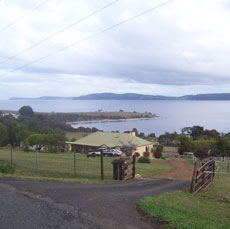
D'Entrecasteaux Channel and Bruny Island from Cape Direction
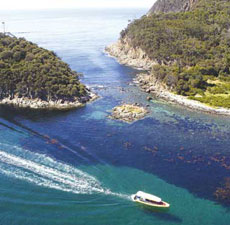
Coastal cliffs, South Bruny Island
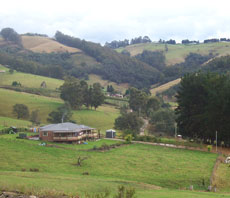
Farms near Cygnet
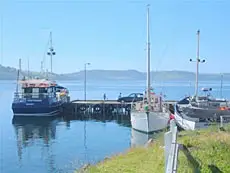
Margate, D'Entrecasteaux Channel
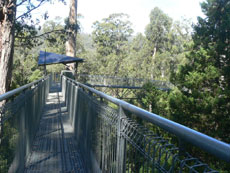
Tahune AirWalk
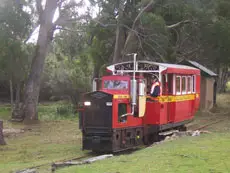
Ida Bay Railway
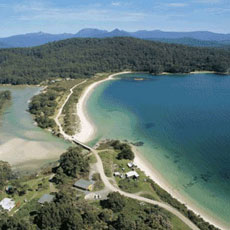
Cockle Creek enters Recherche Bay
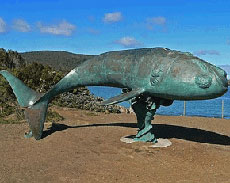
Whale sculpture at Cockle Creek. It was once a thriving whaling and timber milling settlement of over 2,000 people
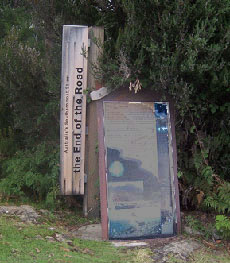
The most southerly point in Australia to which a vehicle can be driven at Cockle Creek
|
No trip to Hobart and Southern Tasmania is complete without a drive along the Huon Trail. Taking in the the fruit growing district of the Huon River valley, Port Huon, Bruny Island and the vast expanse of the D'Entrecasteaux Channel, the Huon Trail incorporates busy towns and sleepy villages, serene boutique farms and World Heritage Wilderness areas accessed by roads that wind through a world of extensive and beautiful valleys and waterways.
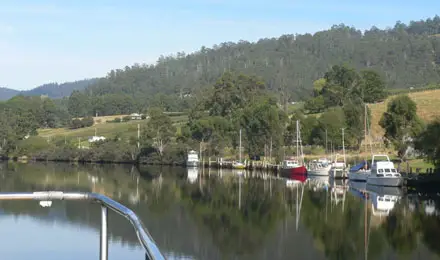
Huon River
The Huon Valley and the coasts of Port Huon and the D'Entrecasteaux Channel are places of natural beauty, perfect for a relaxing holiday, a short break or even a day trip from Hobart. Rich in maritime and rural heritage and populated friendly creative people, the region is known as much for its gorgeous scenery as it huon pine, apple orchards and boutique wineries and gourmet specialities. By big city standards, the roads are always quiet and there is something different around every corner.
Location: south and south-west of Hobart, Tasmania, beside the D'Entrecasteaux Channel, Huon Rover and Port Huon.
Length: short loop (Hobart - Gordon - Huonville - Hobart) - 132 km; full loop (including Cockle Creek) - 304 km
Suggested return journey: follow either the east coast route via Bicheno, or the west coast route via Queenstown. As an alternative, return via Heritage Highway, but take the road via Colebrook, Campania and the historic Georgian village of Richmond between Hobart and Oatlands.
Features/attractions: historic George era towns of Oatlands, Campbell Town, Ross, Tunbridge, Jericho and Kempton.
Minimum duration (one way): short loop (Hobart - Gordon - Huonville - Hobart) - 2 hours 30 minutes; full return loop (including Cockle Creek) - 6 hours
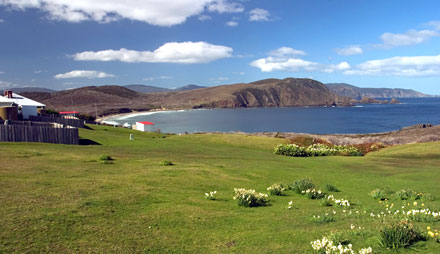
Cloudy Bay, Bruny Island
What You Will See: the loop taken by day trippers leaves Hobart via Channel Highway, passing through Sandy Bay (Wrest Point Casino), Taroona (historic shot tower) and Kingston. A side road to Dennes Point via Blackmans Bays offers panoramic views of D'Entrecasteaux Channel. From Kingston, proceed south through Margate and Snug (Snug Falls). The car ferry to Bruny Island leaves from the village of Kettering. Bruny Island is well worth a visit - allow at least a full day for a brief exploration of the island.
From Kettering, continue south along Channel Highway beside the channel, passing through Woodbridge and Gordon. At the tip of the peninsula, the road winds back northwards alongside the lower Huon River to the pretty village of Cygnet. Continue northwards via the Highway, or follow the coast road to Petcheys Bay for a more scenic drive.
Huonville is the main town and the region and most facilities can be found here. If your visit to the Huon Valley is a day trip, complete the loop by heading back to Hobart via the Huon Highway from Huonville. At Huonville you can visit the Huon Apple & Heritage Museum, take a jet boat ride up the river, or a more leisurely cruise on the MV Southern Contessa.
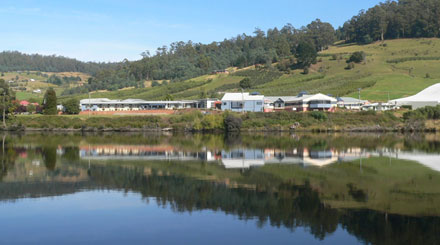
Franklin and Huon River
The drive south from Huonville to Southport is well worth the effort if time permits. The road the eastern bank of the Huon River to Franklin (wooden boat centre) and Geeveston (Forest & Heritage Centre). The latter is a timber milling town and gateway to the rugged Hartz Mountains National Park. Some of the tallest hardwood trees in the world (up to 95 m high) grow here. Geeveston is also the stepping off point for the Tahune AirWalk (a spectacular aerial walkway through the rainforest canopy on the banks of the Huon River) and cruises on Port Huon.
To the south of Geeveston is the fishing port of Dover, with its quaint cottages and English trees was once a convict station. A trip out to three islands in the bay - named Faith, Hope and Charity - is recommended and includes a visit to convict graves on Faith Island. Southport is a sleepy coastal village off the main road. In the early 1800's Southport was a convict station, bustling mill town and international port. Being Tasmania's second largest town at that time, it was proposed as the capital of the colony.
The small town of Hastings is famous for its limestone caves (Hastings Caves; Mystery Creek Caves), thermal springs, Adamson's Falls and Adamson's Peak and local gemstones (Lune River; its post office is the southernmost in Australia). Also on Lune River is the Ida Bay bush railway, originally built to carry limestone.
At the southern end of Recherche Bay where Cockle Creek enters it, a sign marks the southernmost point in Australia to which a motor vehicle can be driven. A walking track from the locality passes through the South West National Park and leads to South East Cape, Australia's most southerly point. It was on the shores of Recherche Bay that French explorer Bruny D'Entrecasteaux repaired his storm-battered ships in 1792. Fish were caught, firewood gathered, charcoal made and a small garden planted. D'Entrecasteaux returned to the bay in January 1793 for more supplies ahead of his long journey home. The bay later became a base for whalers and is today Australia's most southerly settlement.

|